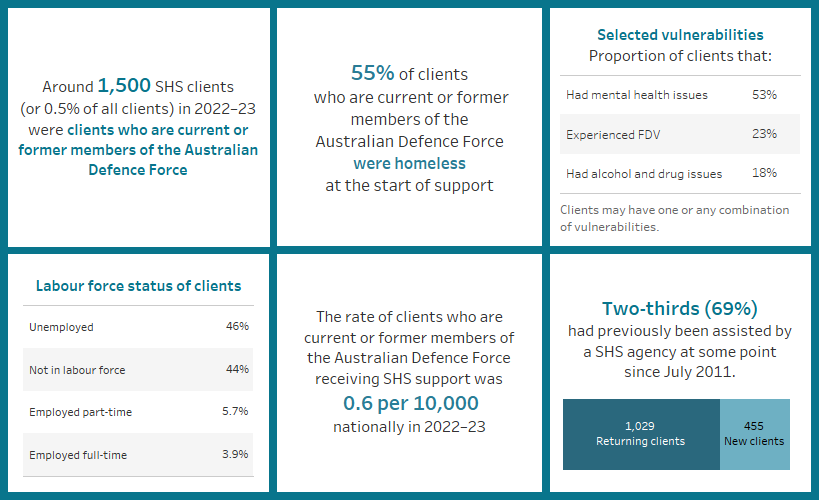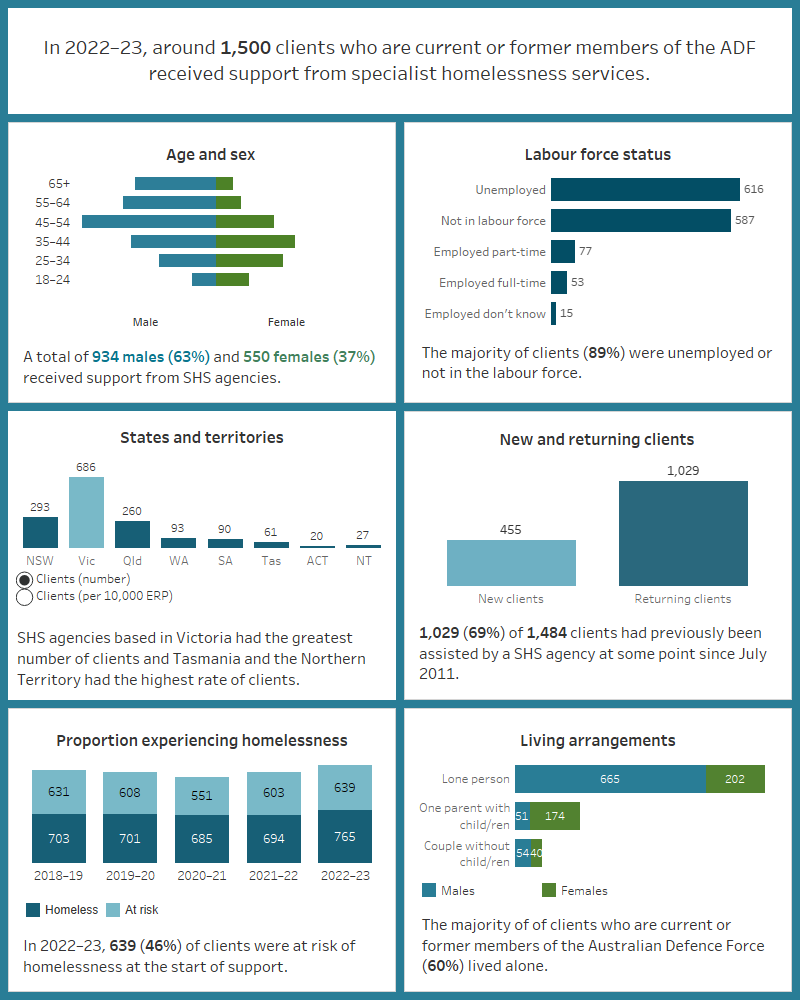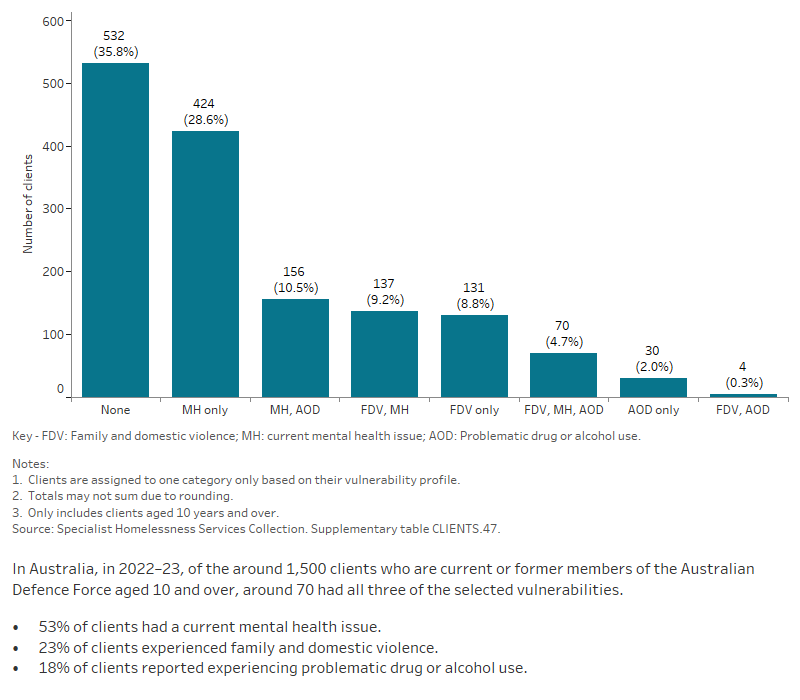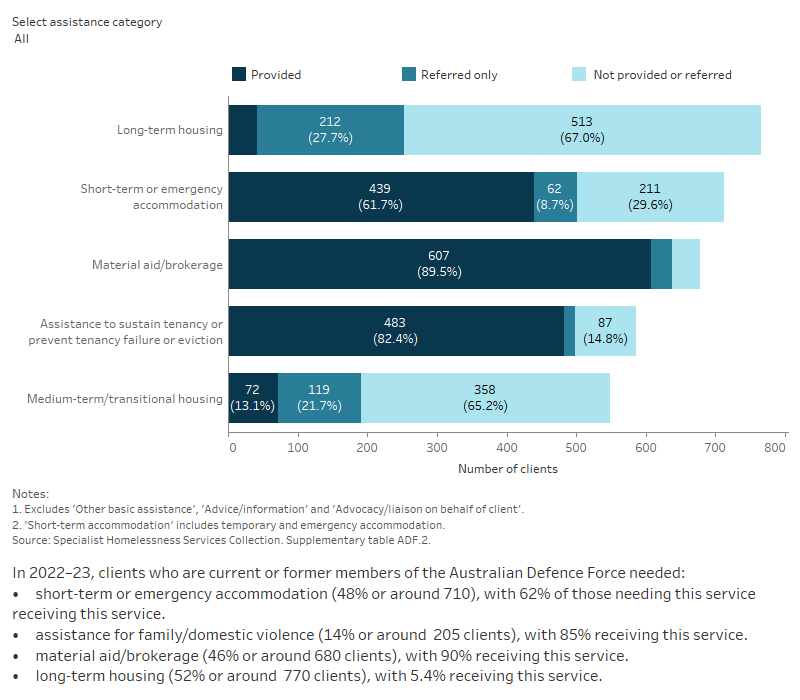Clients who identified as current or former members of the Australian Defence Force (ADF)
On this page
Key findings: SHS clients who are current or former members of the ADF, 2022–23

The long-term welfare of Australian Defence Force (ADF) members is important as Defence members, like any other Australian, may experience homelessness for a number of reasons, including:
- Complex personal needs – mental health issues and other complex vulnerabilities can be reflective of the unique demands of service (McFarlane et al. 2011).
- Financial stress – employment can become an issue for ADF members when transitioning from service to civilian life (Searle et al. 2019).
At 30 June 2023, there were 57,300 permanent current serving ADF members (Defence 2023) and an estimated 595,200 living former serving members (DVA 2023). An estimated 5,800 veterans (or 5.3%) who have transitioned from the ADF experience homelessness every year, compared to 1.9% of the broader population (Hilferty et al. 2019).
Identified risk factors for veterans contributing to a high risk of experiencing homelessness can include being single, being unemployed, experiencing financial strain, having a physical injury, disability, and mental health issue, having less contact with friends or a family because of physical isolation and experiencing a greater number of traumatic events than the broader population (Hilferty et al. 2019).
Eligible current serving ADF personnel can access housing and rental assistance through Defence Housing Australia. Current or former ADF members can access a range of housing and homelessness services through government and non-government organisations, including access to subsidised housing loans, home support loans (cost of maintenance and modifications to their own homes that encourage independent living), insurances, other benefits and discounts (Defence 2022b).
To provide a better understanding of the extent to which current or former ADF members may need support from specialist homelessness services (SHS), the Australian Defence Force (ADF) indicator was introduced into the Specialist Homelessness Services Collection (SHSC) in July 2017.
As is common with new data items, upon implementation there were a high number of ‘don’t know’ (14% in 2017–18) responses to the ADF question. A ‘don’t know’ response is selected if the information is not known or the client refuses to provide the information. The proportion of clients selecting ‘don’t know’ has decreased over time to 6.4% in 2022–23.
The Use of homelessness services by contemporary ex-serving Australian Defence Force members 2011–17 report linked SHSC and Defence personnel data to identify contemporary ex-serving ADF members (those who discharged after 1 January 2001) who had used services between 2011–12 and 2016–17. The report provides a longer-term view of clients, prior to the implementation of the ADF indicator in the SHSC, including information on the profile of ex-serving ADF member SHS clients, and their outcomes at the start and end of support.
In 2022–23 (Supplementary table CLIENTS.41):
- SHS agencies assisted almost 1,500 clients who identified as current or former members of the ADF.
- Clients who identified as current or former members of the ADF made up less than 1% of all SHS clients.
Reporting ADF clients in the Specialist Homelessness Services Collection (SHSC)
The SHS ADF indicator is applied when a client self-identifies as a current or former ADF member. The ADF indicator is not applicable to clients who may have served in non-Australian defence forces, reservists who have never served as a permanent ADF member or clients under the age of 18.
Note: differences between the results of this and other publicly reported estimates may be due to differences in how an ADF member is defined. Further details about the ADF indicator in the SHSC are provided in Technical notes.
Client characteristics
Figure ADF.1: Key demographics, SHS clients who are current or former members of the ADF, 2022–23
This interactive image describes the characteristics of the approximately 1,500 clients who are former or current member of the ADF who received SHS support in 2022–23. The majority of clients were male, aged 45–64. Most were unemployed. Victoria had the most clients and Tasmania had the highest rate of clients per 10,000 population. The majority of clients had previously been assisted by a SHS agency since July 2011. More than half were experiencing homelessness at the start of support. Most were living alone.

Labour force status
In 2022–23, almost half of clients who identified as current or former members of the ADF with a known labour force status were unemployed (46% or 620 clients), and a similar proportion were not in the labour force (44% or 590 clients). Around 1 in 10 clients (11%) were employed when they first presented to a SHS agency (Supplementary table ADF.6).
Living arrangements
In 2023–23, around three-quarters (75% or 1,100 clients) of SHS clients who identified as current or former members of the ADF lived alone or were single parents living with their children. Around one-third (33% or 175 clients) of female clients were single parents living with their children, compared to 5.6% (51 clients) of males (Supplementary table CLIENTS.45).
Selected vulnerabilities
SHS clients in general can face additional vulnerabilities that make them more susceptible to experiencing homelessness, in particular family and domestic violence, a current mental health issue and problematic drug and/or alcohol use. In 2022–23, around two-thirds (64%, or 950 clients) of clients who identified as current or former members of the ADF had at least one of the three selected vulnerabilities, greater than the proportion of the total SHS population (59%, or 135,000 clients) (Supplementary table CLIENTS.47).
Figure ADF.2: Clients who identified as current or former members of the ADF, by selected vulnerability characteristics, 2022–23

Service use patterns
The length of support received by clients who identified as current or former members of the ADF increased from a median of 53 days of support in 2017–18 to 60 days in 2022–23. These clients had an average of 2.6 support periods per client in 2022–23 (Supplementary table CLIENTS.48).
Changes over time since 2017–18
The total number of clients who identified as current or former members of the ADF who received support from SHS agencies increased by an average of 2.8% annually between 2017–18 and 2022–23, from 1,300 clients in 2017–18 to 1,500 in 2022–23 (Supplementary table HIST.ADF). The number of female veterans increased by an average of 4.4% per year over the period, compared with 1.9% for males. This compares to an average decrease of 0.3% per year between 2017–18 and 2022–23 for all SHS clients (Supplementary table HIST.CLIENTS).
New and returning clients
Around one-third (31% or 455 clients) of clients who identified as current or former members of the ADF in 2022–23 were new to SHS agencies, less than the proportion of new clients within the total SHS population (37%) (Supplementary tables CLIENTS.2 and CLIENTS.42). Of those new clients identifying as current or former members of the ADF, one in five were aged 45–54 years (21%), and 65 years and over (22%). (CLIENTS.42).
Around 1,000 (69%) clients returned to SHS agencies for assistance in 2022–23. Males were more likely to be aged 45–54 (31% or around 195 clients), while females were more likely to be aged 35–44 (29% around 115).
Main reasons for seeking assistance
SHS agencies provide a range of support services. For clients who identified as current or former members of the ADF receiving SHS support in 2022–23 (Supplementary tables ADF.4 and ADF.5):
- The main reason for seeking assistance was housing crisis (25% or around 370 clients), followed by inadequate or inappropriate dwelling conditions (16% or 235 clients). This is generally consistent with most other SHS clients in 2022–23.
- Clients currently experiencing homelessness and those at risk of homelessness identified housing crisis as the main reason for seeking assistance (27% or around 210 clients and 24% or almost 155 clients respectively).
- Clients at risk of homelessness were more likely to report family and domestic violence as a main reason for seeking assistance (12%) than clients experiencing homelessness (6.7%).
- Clients at risk of homelessness were more likely to report financial difficulties as a main reason for seeking assistance (18%) than clients presenting as homeless (8.4%).
Services needed and provided
In 2022–23, the provision of support services to clients varied based on their identified need on presentation (Figure ADF.3, Supplementary table ADF.2 and CLIENTS.24):
- Advice/information was the most likely service needed by clients (87% or around 1,300 clients) and was provided to 99% of those who needed it.
- Two-thirds (66%) of clients needed accommodation and it was provided to 52% of those who needed it.
Compared with all SHS clients, clients who identified as current or former members of the ADF were more likely to need:
- advocacy liaison (64% compared with 53% among all SHS clients)
- material aid/brokerage (46% compared with 37%)
- assistance to sustain a tenancy or prevent tenancy failure or eviction (40% compared with 31%).
Figure ADF.3: Clients who identified as current or former members of the Australian Defence Force: services needed and provided, 2022–23
This interactive stacked horizontal bar graph shows the services needed by clients who identified as current or former members of the ADF and their provision status. Long-term housing was the most needed and the least provided service. Material aid/brokerage was the most provided service.

Housing situation
In 2022–23, of those clients who identified as current or former members of the ADF (Supplementary tables ADF.3 and CLIENTS.11):
- On presentation to services for assistance more than half of clients (54%) were experiencing homelessness (compared with 47% of all SHS clients):
- 22% (305 clients) were rough sleeping (compared with 10% of all SHS clients).
- 20% (around 275 clients) were in short-term or emergency accommodation (compared with 17%)
- Just under half (46%) presented to services at risk of homelessness (compared with 53%):
- 30% were in private or other housing (compared with 31%)
- 8.5% were in public or community housing (compared with 12%).
Department of Defence (2023) Annual report 2022-23, Defence website, accessed on 2 November 2023.
Department of Defence (2022) ADF Member And family transition guide, Department of Defence, accessed on 1 September 2023.
Department of Veterans Affairs (2023) Annual report 2022-23, DVA website, accessed on 2 November 2023.
Hilferty F, Katz I, Zmudzki F, Hooff M, Lawrence-Wood E, Searle A, Evans G, Challinor B, and Talbot A 2019 Homelessness amongst Australian veterans, report to the Australian Government Department of Veterans’ Affairs, AHURI.
McFarlane A, Hodson S, Van Hooff M and Davies C (2011) Mental health in the Australian Defence Force: 2010 ADF Mental Health and Wellbeing Study: Full report, Department of Defence, Canberra.
Searle, A, Van Hooff M, Lawrence-Wood E, Hilferty F, Katz I, Zmudzki F and McFarlane A (2019) Homelessness amongst Australian contemporary veterans: pathways from military and transition risk factors, report to the Australian Government Department of Veterans’ Affairs, AHURI.


